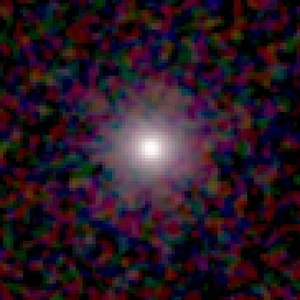NGC 75 facts for kids
Quick facts for kids NGC 75 |
|
|---|---|

Image from 2MASS
|
|
| Observation data | |
| Constellation | Pisces |
| Type | Lenticular galaxy |
| Apparent magnitude (V) | 13.2 |
| See also: Galaxy, List of galaxies | |
NGC 75 is a fascinating galaxy located in the Pisces constellation. It's a special type of galaxy known as a lenticular galaxy, which means it looks like a mix between a spiral galaxy and an elliptical galaxy. This distant galaxy was first spotted by an astronomer named Lewis A. Swift in 1886.
Contents
What is NGC 75?
NGC 75 is a galaxy, which is a huge collection of stars, gas, dust, and dark matter, all held together by gravity. Our own solar system, including Earth, is part of a galaxy called the Milky Way. NGC 75 is much farther away than anything in our solar system.
Lenticular Galaxies Explained
Lenticular galaxies, like NGC 75, have a bright central bulge and a flat disk, but they don't have the clear spiral arms that you see in galaxies like the Milky Way. They also don't have much gas and dust, which means they aren't forming many new stars. Scientists believe that lenticular galaxies might have once been spiral galaxies that lost their gas and dust, perhaps after colliding with another galaxy or using up their star-forming material.
Where is NGC 75 Located?
NGC 75 is found in the Pisces constellation. Pisces is one of the 12 zodiac constellations, often seen as two fish connected by a cord. You can usually spot Pisces in the autumn sky in the Northern Hemisphere. Finding NGC 75 would require a powerful telescope, as it's very far away and not visible to the naked eye.
Who Discovered NGC 75?
NGC 75 was discovered by Lewis A. Swift on October 22, 1886. Swift was an American astronomer who became famous for discovering many comets and nebulae. He used telescopes to scan the night sky, carefully noting down new objects he found. His discoveries helped map out more of our universe.
How Do We Study Galaxies?
Astronomers use powerful telescopes, both on Earth and in space, to study galaxies like NGC 75. These telescopes collect light from distant objects, allowing scientists to learn about their size, shape, and how they move. By studying different types of galaxies, we can understand more about how the universe formed and how it continues to change.
Light-Years and Distance
When we talk about distances to galaxies, we use a unit called a light-year. A light-year is the distance light travels in one year. Light travels incredibly fast, about 300,000 kilometers (186,000 miles) per second! So, when we say a galaxy is millions of light-years away, it means the light we see from it today left that galaxy millions of years ago. We are essentially looking back in time when we observe distant galaxies.
See also
 In Spanish: NGC 75 para niños
In Spanish: NGC 75 para niños

